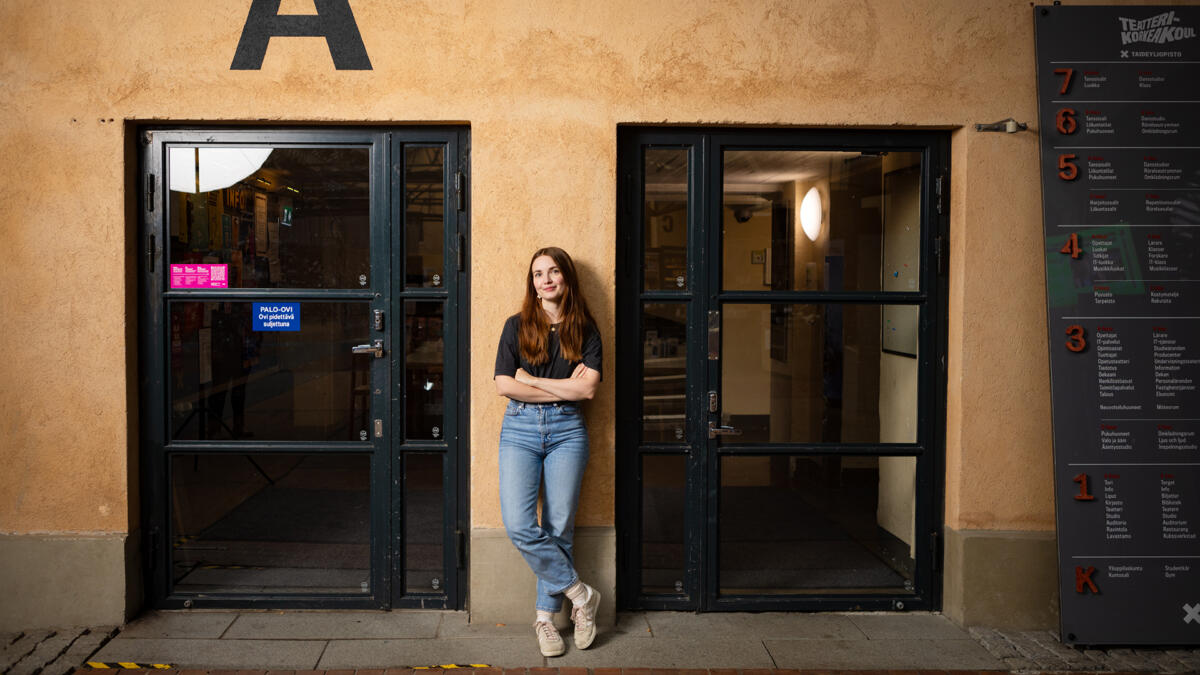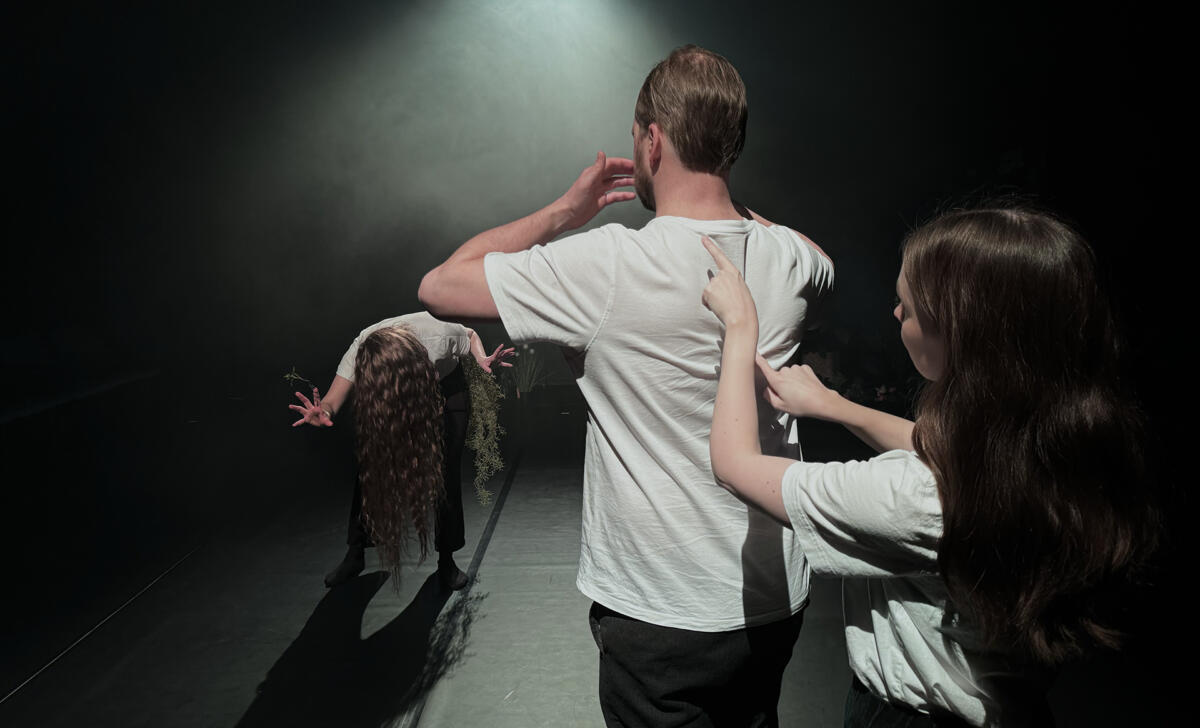Doctoral researcher Noora Karjalainen wants to put the deaf experience at centre of theatre
When the premise of a performance is the parallel reality of the deaf, what emerges is a new kind of aesthetic. It has a lot to offer for the entire theatre field, believes Noora Karjalainen, who is working on her doctoral dissertation at Uniarts Helsinki’s Theatre Academy.

Typically, deafness is discussed in the performing arts from the perspective of accessibility. The goal is to give deaf viewers an experience that resembles what the hearing audience experiences as accurately as possible.
But Noora Karjalainen, a doctoral researcher and theatre artist at the Theatre Academy, is not interested in the accessibility angle. Her practice is first and foremost deaf-centred.
“A hearing person’s experience of a particular work is not a state that needs to be reached, and sign language and deafness are not obstacles that we must try to overcome. I’m not trying to fit deaf people into the theatre tradition of hearing people, but instead, I want to explore what kind of art is created when deaf people’s experiences are put at centre of theatre,” Karjalainen says.
In her research, Karjalainen examines artistic agency in the contexts of theatre and theatre pedagogy through the lived experience of the deaf.
“The basis of my practice is that I strive to provide deaf people and other sign language users with the kinds of conditions for artistic and pedagogical work in which they are allowed to be deaf.”
Before rehearsals, one of the things that Karjalainen considers is the choice of space: Does the space have an unobstructed view? Maybe some reflective surfaces that can provide more visual information? A spring floor that makes it easy to sense vibrations? What about the lighting, is it good enough? A good space gives actors tools to use their senses in a versatile way.
The practice emphasises the importance of corporeality, visuality and touch. Sign language, gestures, facial expressions and body movement are essential communication tools.
A deaf-centric perspective opens up new possibilities for theatres where the focus is not on the hearing actor or audience. It also invites hearing people to examine the fundamentals of theatre-making in a new way. Karjalainen’s practice utilises the diverse expression
methods of the art form and, at the same time, she challenges the normativity associated with hearing.
If we want to strive for a more inclusive stage, for example, involving a certain minority group is not enough in and of itself. We must be in a truly reciprocal relationship with each other and surrender to the fact that outside of our own notion of art, there are other parallel realities with their own conceptions of art, which we cannot control but from which we can learn and with which we can flourish together.”
There are concrete examples of such coexistence in the history of theatre. By combining mime and sign language, pantomime artist Marcel Marceau’s deaf apprentice Bernard Bragg developed a new genre of visual storytelling, Visual Vernacular, which has exploded in popularity in the deaf community in recent years.
“I’m interested in what theatre could be in this specific reality, what kind of aesthetics and stage action it inspires.”
Directing on the terms of the deaf reality
Karjalainen is the artistic director and founding member of the theatre group Ursa Minor Ensemble. When working in the ensemble, Karjalainen uses embodied, multimodal and trauma-sensitive methods that utilise various different means of bodily expression.
“I’m coming up with a new kind of directing practice where I explore how I can give instructions to actors in other ways than by signing. Instructions can be given, for example, through touch, body movement and positions and sense of sight. Vibration, tactile messages, lights, movement and different materials can also be used,” she describes the process.
In a work called Growth (2021), the group communicated through vibration and changes in lighting. The vibrations sensed through the floor evoked an association with a specific action, a loud bump, stomping and dimming of the lights made the actors withdraw into themselves, while a light patter, the expanding warmth from the lights and airflow made them open up.
“When an actor can’t hear, they still sense the situation and the action on stage through their other senses. A vibration, for example, can tell the distance, direction, intensity and magnitude of a motion.”

Communication with the audience, too, can happen through visual cues instead of auditory ones.
“In our play that we prepared last year, Kuvanveistäjä (The Sculptor), it was not the sound of footsteps that indicated that a character was approaching but the stage actor’s reaction to the character arriving. This small gesture also served as a signal for the fellow actor to arrive on stage.”
In her work, Karjalainen strives to find methods that are natural in the deaf reality. For her, the pursuit of naturalness is a radical act that conveys the message that deaf bodies are “ready, good and perfect as they are.”
“We don’t need to hear to be part of this world. We just are.”
The message is important because it is still not self-evident. Karjalainen lists some of the cruel acts against deaf people over the course of history: eugenics, oralism, compulsory sterilisation, marriage law. Today’s topic of debate is gene therapy aiming at removing deafness genes.
“In my own work, I want to create a safe space where deaf people can be deaf.”
Untapped potential
For Karjalainen, Ursa Minor Ensemble is “one way to give deaf actors the opportunity to learn and evolve as actors.”
The theatre group was established after Karjalainen’s master’s thesis laboratory.
“The same group wanted to continue on a journey together, and I felt that this way I could give to others what I myself had been given and what I had learned so we could grow together.”
Karjalainen points out that these kinds of opportunities for deaf actors to evolve are few and far between.
When it comes to acting education, for example, the glass ceiling is still thick, and so far, not a single deaf person in Finland has completed the five-year acting programme.”
Some Finnish deaf people have gone abroad to seek acting training. To date, three deaf students have graduated from different degree programmes of the Theatre Academy.
Theatre for the deaf and sign language users has always been marginalised in Finland, but it has a long history.
“As far as we know, the history of deaf theatre in Finland goes back as far as the second half of the 1800s, when deaf people performed various plays in schools for the deaf and at
deaf associations, for example. Today, we have two professional sign language theatres,” Karjalainen says.
Karjalainen draws attention to the fact that deaf actors and the deaf theatre provide a fertile soil for the Finnish performing arts ecosystem. They have enormous artistic potential.
“Over the past ten years, there have been a small handful of collaborative performances between deaf and hearing people in state-subsidised theatres. I believe that this is partly due to the lack of information and competence related to deafness and sign language among hearing people and partly due to the fact that deaf people have not been able to enter programmes and thereby networks in the field,” Karjalainen says.
Internationally speaking, we are lagging behind.
“In the United States and Great Britain, for example, cooperation between deaf and hearing theatres in both smaller and larger theatres has been going on for a long time. In Norway, Sweden and France, deaf theatres have a stable position and their own home stage. Bachelor’s programmes in acting have been available in sign language in Sweden and Scotland. Especially in the UK and the United States, deaf actors find employment in a wide range of theatre, film and TV productions.”
In fact, the future of deaf actors and sign language theatre in Finland worries Karjalainen.
“For the development of sign language and deaf theatre, we desperately need deaf and sign language using theatre professionals and facilities for working, otherwise the field will wither away.”
According to Karjalainen, the deaf community has a persistent dream of an acting programme in sign language.
“It tells me that deaf theatre and Sign Language Art are attractive artistic fields. In the international sign language community, Sign Language Art is now developing at a furious pace.”
Karjalainen hopes that the deaf theatre will not remain just a “secret within the community”.
“Representation makes a huge difference. When sign language and deafness are prominently featured in theatre programmes, either as co-productions or as independent guest productions, it sends a clear message of appreciation for sign language and deaf culture. And this is the kind of coexistence where we can grow together.”
Bio
Noora Karjalainen
- Doctoral researcher at Uniarts Helsinki’s Theatre Academy
- Master’s degree in theatre pedagogy from Uniarts Helsinki’s Theatre Academy, previous studies at Turku Arts Academy and Stockholms Dramatiska Högskola
- Artistic director and founding member of the sign language art cooperative Ursa Minor
- Chair of the Kuurojen Taiteilijakilta (Deaf Artists’ Guild) association